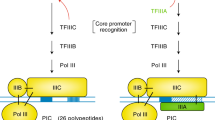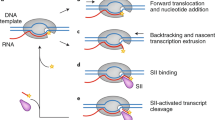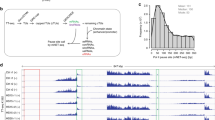Abstract
Transcriptional activation of RNA polymerase II in eukaryotic organisms ranging from yeasts to mammals has many common features such as enhancer elements, TATA elements, and activator proteins that bind specifically to promoter DNA (reviewed in refs (1, 2). The JUN oncoprotein, which causes sarcomas in chickens3, shows significant homology to the DNA-binding domain of GCN4, a yeast protein that stimulates transcription of the amino acid biosynthetic genes4. The GCN4 and JUN proteins bind the same DNA sequences5, consensus ATGA(C/G)TCAT (ref. 6), even though the DNA-binding domains are only 45% identical in amino acid sequence. The JUN protein almost certainly represents the oncogenic version of the normal AP-1 transcription factor7, sug-gesting an evolutionary relationship between yeast and vertebrate activator proteins. Here, I demonstrate that JUN efficiently activates transcription in yeast either through its own or a heterologous DNA-binding domain. As is the case for yeast activator proteins, transcriptional stimulation by JUN requires an acidic activation region distinct from the DNA-binding domain. The functional interchangeability between yeast and vertebrate transcription factors strongly suggests a basic similarity in the molecular mechanism of eukaryotic transcriptional activation.
This is a preview of subscription content, access via your institution
Access options
Subscribe to this journal
Receive 51 print issues and online access
$199.00 per year
only $3.90 per issue
Buy this article
- Purchase on Springer Link
- Instant access to full article PDF
Prices may be subject to local taxes which are calculated during checkout
Similar content being viewed by others
References
Struhl, K. Cell 49, 295–297 (1987).
McKnight, S. L. & Tjian, R. Cell 46, 795–805 (1986).
Maki, Y., Bos, T. J., Davis, C., Starbuck, M., & Vogt, P. K. Proc. natn. Acad. Sci. U.S.A. 84, 2848–2852 (1987).
Vogt, P. K., Bos, T. J., & Dooliltle, R. F. Proc. natn. Acad. Sci. U.S.A. 84, 3316–3319 (1987).
Struhl, K. Cell 50, 841–846 (1987).
Hill, D. E., Hope, I. A., Macke, J. P. & Struhl, K. Science 234, 451–457 (1986).
Bohmann, D., Bos, T. J., Admon, A., Nishimura, T., Vogt, P. K. & Tjian, R. Science 238, 1386–1392 (1987).
Hope, I. A. & Struhl, K. Cell 43, 177–188 (1985).
Arndt, K. & Fink, G. Proc. natn. Acad. Sci. U.S.A. 83, 8516–8520 (1986).
Hope, I. A. & Struhl, K. EMBO J. 6, 2781–2784 (1987).
Hope, I. A. & Struhl, K. Cell 46, 885–894 (1986).
Ma, J. & Ptashne, M. Cell 48, 847–853 (1987).
Ma, J. & Ptashne, M. Cell 51, 113–139 (1987).
Brent, R. & Ptashne, M. Cell 43, 729–736 (1985).
Chen, W., Tabor, S. & Struhl, K. Cell 50, 1047–1055 (1987).
Kakidani, H. & Ptashne, M. Cell 52, 161–167 (1988).
Webster, N., Jin, K. R., Green, S., Hollis, M. & Chambon, P. Cell 52, 16
Lech, K., Anderson, K. & Brent, R. Cell 52, 179–184 (1988).
Author information
Authors and Affiliations
Rights and permissions
About this article
Cite this article
Struhl, K. The JUN oncoprotein, a vertebrate transcription factor, activates transcription in yeast. Nature 332, 649–650 (1988). https://doi.org/10.1038/332649a0
Received:
Accepted:
Issue Date:
DOI: https://doi.org/10.1038/332649a0
This article is cited by
-
A novel protein-DNA interaction involved with the CpG dinucleotide at −30 upstream is linked to the DNA methylation mediated transcription silencing of the MAGE-A1 gene
Cell Research (2004)
-
Mammalian transcription factors in yeast: strangers in a familiar land
Nature Reviews Molecular Cell Biology (2002)
-
A complex interplay of positive and negative elements is responsible for the different transcriptional activity of liver NF1 variants
Molecular Biology Reports (1995)
-
Control of the expression of the ADE2 gene of the yeast Saccharomyces cerevisiae
Current Genetics (1994)
-
A plant histone gene promoter can direct both replication-dependent and -independent gene expression in transgenic plants
Molecular and General Genetics MGG (1992)
Comments
By submitting a comment you agree to abide by our Terms and Community Guidelines. If you find something abusive or that does not comply with our terms or guidelines please flag it as inappropriate.



